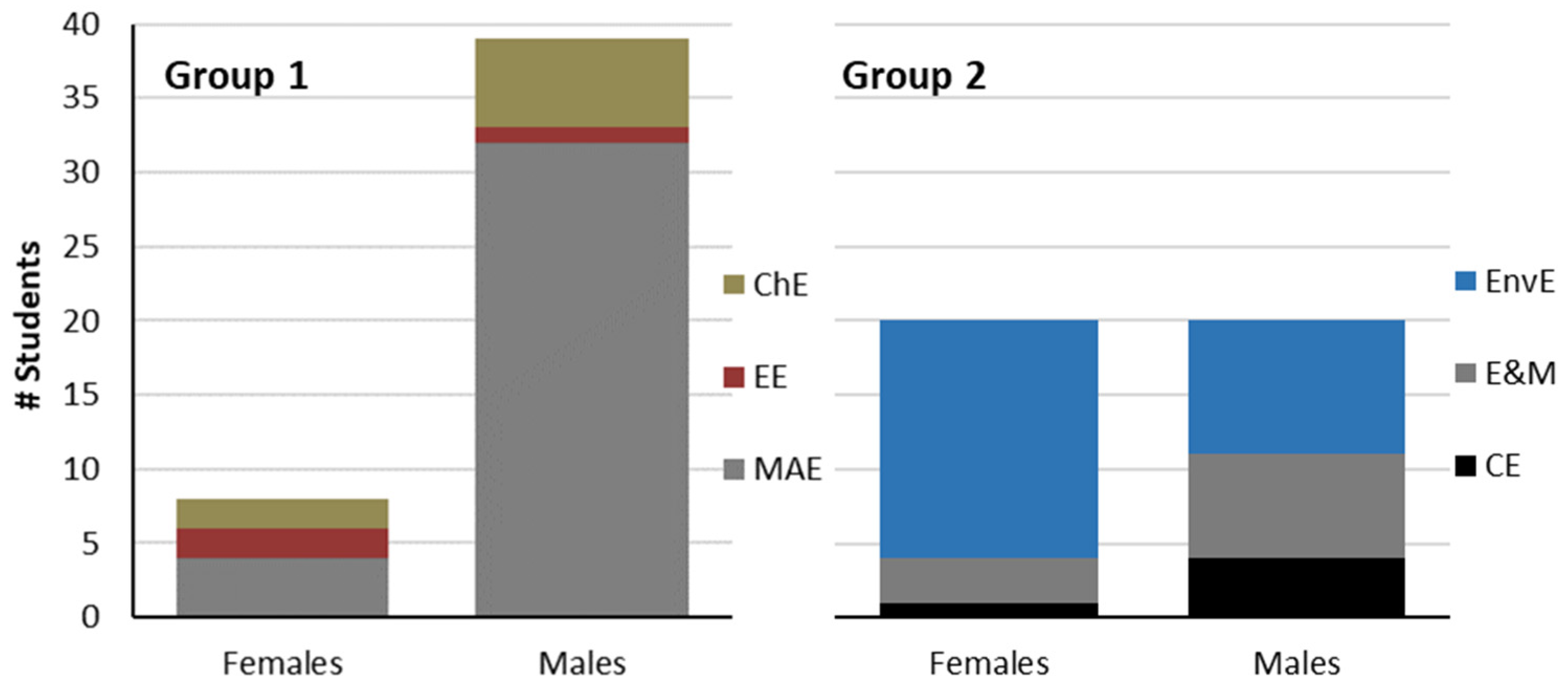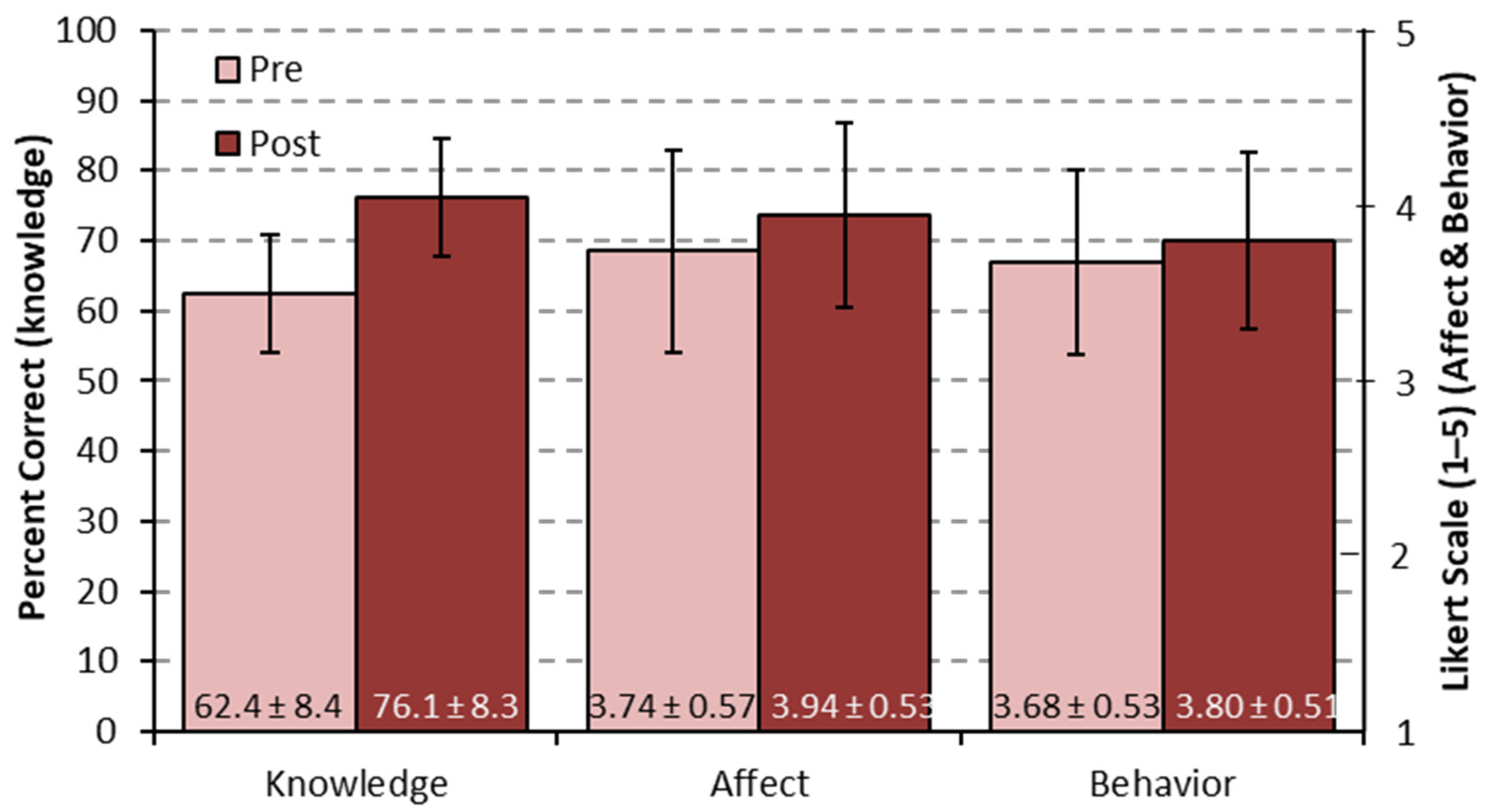Climate Literacy—Imperative Competencies for Tomorrow’s Engineers
Abstract
:1. Introduction
- (1)
- apply engineering design to produce solutions that meet specified needs with consideration of public health, safety, and welfare, as well as global, cultural, social, environmental, and economic factors, and
- (2)
- recognize ethical and professional responsibilities in engineering situations and make informed judgements, which must consider the impact of engineering solutions in global, economic, environmental, and societal contexts (Criteria 3.2 and 3.4) [3].
2. Project Overview and Objectives
- How climate literate are engineering students?
- Does this course increase their overall climate literacy?
- At the end of the semester, do the students have the self-efficacy to effectively integrate climate change perspectives into their profession?
- At the end of the course, have the students demonstrated that they have the technical and critical-thinking skills and competencies to address climate change in their profession?
3. Methods
3.1. The Course—Global Climate Change: Science, Engineering, and Policy
3.2. Participants
3.3. Survey Instruments and Implementation
4. Results and Discussion
4.1. Climate Literacy
4.2. Student Feelings of Competency Related to Climate Change and Engineering Goals
4.3. Variability in Climate Literacy and Self-Efficacy among Student Groups
4.4. Competencies Required to Address Climate Change
4.5. Limitations and Future Directions
5. Conclusions
- (1)
- Students are better prepared for multidimensional and systems thinking for any grand challenges they may face, not just climate change; and,
- (2)
- These students are better prepared to integrate climate change and other environmental and social impacts into their engineering decisions, which should set the stage for developing engineering professionals that are needed for leadership to address global societal challenges.
Author Contributions
Funding
Institutional Review Board Statement
Informed Consent Statement
Data Availability Statement
Conflicts of Interest
References
- Fri, R.W. Bringing Climate Down to Earth. Bridge 2010, 40, 3–4. Available online: http://www.nae.edu/Publications/Bridge/24514/24523.aspx (accessed on 1 June 2021).
- Smith, K.A.; Olds, B.M.; Fortenberry, N.; Bond, S.; Haghighi, K. The Time is Now: Are We Ready for Our Role? J. Eng. Educ. 2008, 97, 119–123. [Google Scholar]
- ABET. Criteria for Accrediting Engineering Programs, 2020–2021. Available online: https://www.abet.org/accreditation/accreditation-criteria/criteria-for-accrediting-engineering-programs-2021-2022/ (accessed on 28 April 2021).
- ASCE. Code of Ethics. 2006. Available online: http://www.asce.org/code-of-ethics/ (accessed on 28 August 2015).
- Shealy, T.; Godwin, A.; Gardner, H. Survey Development to Measure the Gap Between Student Awareness, Literacy, and Action to Address Human-caused Climate Change. In Proceedings of the ASEE Annual Conference, Columbus, OH, USA, 25–28 June 2017. [Google Scholar]
- Shealy, T.; Valdes-Vasquez, R.; Klotz, L.; Potvin, G.; Godwin, A.; Cribbs, J.; Hazari, Z. Half of Students Interested in Civil Engineering Do Not Believe in Anthropogenic Climate Change. J. Prof. Issues Eng. Educ. Pr. 2017, 143, D4016003. [Google Scholar] [CrossRef]
- Nelson, N.; Montefiore, L.; Anthony, C.; Merriman, L.; Kuster, E.; Fox, G. Undergraduate Perceptions of Climate Education Exposure in Natural Resources Management. Trans. ASABE 2019, 62, 831–839. [Google Scholar] [CrossRef]
- Atman, C.J.; Nair, I. Engineering in Context: An Empirical Study of Freshmen Students’ Conceptual Frameworks. J. Eng. Educ. 1996, 85, 317–326. [Google Scholar] [CrossRef]
- Mahaffy, P.G.; Martin, B.E.; Kirchhoff, M.; McKenzie, L.; Holme, T.; Versprille, A.; Towns, M. Infusing Sustainability Science Literacy through Chemistry Education: Climate Science as a Rich Context for Learning Chemistry. ACS Sustain. Chem. Eng. 2014, 2, 2488–2494. [Google Scholar] [CrossRef] [Green Version]
- Mochizuki, Y.; Bryan, A. Climate Change Education in the Context of Education for Sustainable Development: Rationale and Principles. J. Educ. Sustain. Dev. 2015, 9, 4–26. [Google Scholar] [CrossRef]
- Passow, H.J.; Passow, C.H. What Competencies Should Undergraduate Engineering Programs Emphasize? A Systematic Review. J. Eng. Educ. 2017, 106, 475–526. [Google Scholar] [CrossRef]
- Trevelyan, J. Transitioning to engineering practice. Eur. J. Eng. Educ. 2019, 44, 821–837. [Google Scholar] [CrossRef] [Green Version]
- Segalàs, J.; Ferrer-Balas, D.; Mulder, K.F. What do engineering students learn in sustainability courses? The effect of the pedagogical approach. J. Clean. Prod. 2010, 18, 275–284. [Google Scholar] [CrossRef]
- Allenby, B.; Murphy, C.F.; Allen, D.; Davidson, C. Sustainable engineering education in the United States. Sustain. Sci. 2009, 4, 7–15. [Google Scholar] [CrossRef]
- Quelhas, O.L.G.; Lima, G.B.A.; Ludolf, N.V.-E.; Meiriño, M.J.; Abreu, C.; Anholon, R.; Neto, J.V.; Rodrigues, L.S.G. Engineering education and the development of competencies for sustainability. Int. J. Sustain. High. Educ. 2019, 20, 614–629. [Google Scholar] [CrossRef]
- Lozano, R.; Merrill, M.Y.; Sammalisto, K.; Ceulemans, K.; Lozano, F.J. Connecting Competences and Pedagogical Approaches for Sustainable Development in Higher Education: A Literature Review and Framework Proposal. Sustainability 2017, 9, 1889. [Google Scholar] [CrossRef] [Green Version]
- McCright, A.M.; O’Shea, B.W.; Sweeder, R.D.; Urquhart, G.R.; Zeleke, A. Promoting interdisciplinarity through climate change education. Nat. Clim. Chang. 2013, 3, 713–716. [Google Scholar] [CrossRef]
- Christie, M.; De Graaff, E. The philosophical and pedagogical underpinnings of Active Learning in Engineering Education. Eur. J. Eng. Educ. 2016, 42, 5–16. [Google Scholar] [CrossRef]
- Springer, L.; Stanne, M.E.; Donovan, S.S. Effects of small-group learning on undergraduates in science, mathematics, engineering, and technology: A meta-analysis. Rev. Educ. Res. 1999, 69, 21–51. [Google Scholar] [CrossRef]
- National Research Council. How Students Learn: Science in the Classroom; National Academy Press: Washington, DC, USA, 2005. [Google Scholar]
- Baldwin, R.G. Improving the Climate for Undergraduate Teaching and Learning in STEM Fields; Jossey-Bass: San Francisco, CA, USA, 2009. [Google Scholar]
- Roy, J. Engineering by the Numbers; ASEE: Washington, DC, USA, 2019; Available online: https://ira.asee.org/wp-content/uploads/2019/07/2018-Engineering-by-Numbers-Engineering-Statistics-UPDATED-15-July-2019.pdf (accessed on 19 May 2021).
- Powers, S.E.; Dewaters, J.; Dhaniyala, S.; Small, M.M.M. New Project-Based Instructional Modules Improve Climate Change Literacy (Research to Practice). In Proceedings of the 2013 ASEE Annual Conference & Exposition, Atlanta, GA, USA, 23–26 June 2013; Volume 23, pp. 23.928.1–23.928.11. [Google Scholar]
- Abdel-Gaid, S.; Trueblood, C.R.; Shrigley, R.L. A systematic procedure for constructing a valid microcomputer attitude scale. J. Res. Sci. Teach. 1986, 23, 823–839. [Google Scholar] [CrossRef]
- Xie, Y.; De Vellis, R.F. Scale Development: Theory and Applications. Contemp. Sociol. 1991, 21, 876. [Google Scholar] [CrossRef]
- Qaqish, B. Developing Multiple Choice Tests for Social Work Trainings. Train. Dev. Hum. Serv. 2006, 3, 45–57. [Google Scholar]
- U.S. Global Change Research Program. Climate Literacy: The Essential Principles of Climate Science, (ver. 2). Washington, DC, USA. 2009. Available online: http://www.climate.noaa.gov/education/pdfs/ClimateLiteracy-8.5x11-March09FinalHR.pdf (accessed on 1 July 2009).
- Powers, S.; Dewaters, J.; Grimberg, S.; Hou, D.; Small, M.M. CLICS—Integrating Data from Campus Sustainability Projects Across Disciplines. In Proceedings of the 2015 ASEE Annual Conference & Exposition, Seattle, WA, USA, 14–17 June 2015; pp. 26.351.1–26.351.15. [Google Scholar]
- Niewoehner, R. Critical Thinking in the Engineering Enterprise. In The Magazine for Professional Engineers; National Society of Professional Engineers: Alexandria, VA, USA, 2008; pp. 16–17. [Google Scholar]
- Shelley, M.; Krippendorff, K. Content Analysis: An Introduction to its Methodology. J. Am. Stat. Assoc. 1984, 79, 240. [Google Scholar] [CrossRef] [Green Version]
- Huxster, J.; Uribe-Zarain, X.; Kempton, W. Undergraduate Understanding of Climate Change: The Influences of College Major and Environmental Group Membership on Survey Knowledge Scores. J. Environ. Educ. 2015, 46, 149–165. [Google Scholar] [CrossRef]
- Gautier, C.; Deutsch, K.; Rebich, S. Misconceptions About the Greenhouse Effect. J. Geosci. Educ. 2006, 54, 386–395. [Google Scholar] [CrossRef]
- Attari, S.Z.; DeKay, M.L.; Davidson, C.I.; DE Bruin, W.B. Public perceptions of energy consumption and savings. Proc. Natl. Acad. Sci. USA 2010, 107, 16054–16059. [Google Scholar] [CrossRef] [PubMed] [Green Version]
- DeWaters, J.E.; Powers, S.E. Energy literacy of secondary students in New York State (USA): A measure of knowledge, affect, and behavior. Energy Policy 2011, 39, 1699–1710. [Google Scholar] [CrossRef]
- Meyers, K.; Mertz, B. A Large Scale Analysis of First-Year Engineering Student Essays on Engineering Interests. In Proceedings of the 118th ASEE Annual Conference, Vancouver, BC, Canada, 26–29 June 2011; pp. 22.52.1–22.52.16. [Google Scholar]
- Goodwin, A.; Potvin, G.; Hazari, Z. The Development of Critical Engineering Agency, Identity and the Impact on Engineering Career Choices. In Proceedings of the 120th ASEE Annual Conference, Atlanta, GA, USA, 23–26 June 2013. [Google Scholar]





| Our Climate is Changing (1.5 weeks) |
|
| Climate Science (4 weeks) |
|
| Mitigating Climate Change (2.5 weeks) |
|
| Adapting to Climate Change (1.5 weeks) |
|
| Synthesis (2 weeks) |
|
| Rubric Attributes | Competency Expectations—Example for a “Proficient” Score of 4 |
|---|---|
| Formulates problem/question or issue |
|
| Uses data and evidence appropriately, objectively, and systematically to address a problem |
|
| Formulates evidence-based conclusion or problem solution |
|
| Evaluates solution |
|
| Survey Items | Pre-Test Average | Post-Test Average 1 |
|---|---|---|
| Climate Science | ||
| CO2 is the greenhouse gas we are most concerned about limiting emissions of, to reduce global warming. | 74.2 | 95.5 *** |
| Energy in the infrared wavelength is absorbed by the atmosphere and mainly causes temperature increase. | 28.1 | 76.4 *** |
| The greenhouse effect is caused by naturally occurring gases in the atmosphere. | 68.5 | 82.0 ** |
| Causes and Effects of Climate Change | ||
| Anthropogenic causes of global climate change (overall score) | 60.7 | 74.1 *** |
| Fossil fuel combustion is a cause of climate change. | 93.8 | 98.6 *** |
| The ozone hole in the upper atmosphere is not a cause of climate change. | 22.5 | 46.6 *** |
| Real and possible consequences of global climate change (overall score) | 71.4 | 80.7 *** |
| Climate Change Mitigation Strategies | ||
| Actions that will help reduce or slow down climate change (overall score) | 68.2 | 76.2 *** |
| Student understanding of the magnitude and causes of climate change: % of students who … | ||
| Selected climate change 2 as the most important environmental problem facing the U.S. today | 21.3 | 60.7 NA |
| Selected burning fossil fuels 3 as the most significant cause of global climate change. | 80.9 | 98.9 NA |
| Survey Items (Followed by Likert-Type Response Option) | Average Score (out of 5) 1 | % Positive Response 2 |
|---|---|---|
| I feel I know (a lot, quite a bit) about global climate change. | 3.92 ± 0.51 *** | 85.4 |
| I am (completely, mostly) convinced that global warming is happening. | 4.69 ± 0.47 *** | 100.0 |
| Global warming is caused (mostly by human activities). | 4.72 ± 0.67 ** | 80.9 |
| Global warming is an (urgent/very serious) threat to: | ||
| 4.08 ± 0.76 *** | 79.8 |
| 3.63 ± 0.86 * | 51.7 |
| 3.02 ± 1.00 | 28.1 |
| I would (strongly/somewhat favor) requiring automakers to increase the fuel efficiency of cars to 35 miles per gallon, even if a new car would cost $500 more. | 4.52 ± 0.83 ** | 87.6 |
| I would (strongly/somewhat favor) increasing taxes on gasoline so people either drive less or buy cars that use less gas. | 3.24 ± 1.41 | 52.8 |
Publisher’s Note: MDPI stays neutral with regard to jurisdictional claims in published maps and institutional affiliations. |
© 2021 by the authors. Licensee MDPI, Basel, Switzerland. This article is an open access article distributed under the terms and conditions of the Creative Commons Attribution (CC BY) license (https://creativecommons.org/licenses/by/4.0/).
Share and Cite
Powers, S.E.; DeWaters, J.E.; Dhaniyala, S. Climate Literacy—Imperative Competencies for Tomorrow’s Engineers. Sustainability 2021, 13, 9684. https://doi.org/10.3390/su13179684
Powers SE, DeWaters JE, Dhaniyala S. Climate Literacy—Imperative Competencies for Tomorrow’s Engineers. Sustainability. 2021; 13(17):9684. https://doi.org/10.3390/su13179684
Chicago/Turabian StylePowers, Susan E., Jan E. DeWaters, and Suresh Dhaniyala. 2021. "Climate Literacy—Imperative Competencies for Tomorrow’s Engineers" Sustainability 13, no. 17: 9684. https://doi.org/10.3390/su13179684
APA StylePowers, S. E., DeWaters, J. E., & Dhaniyala, S. (2021). Climate Literacy—Imperative Competencies for Tomorrow’s Engineers. Sustainability, 13(17), 9684. https://doi.org/10.3390/su13179684







